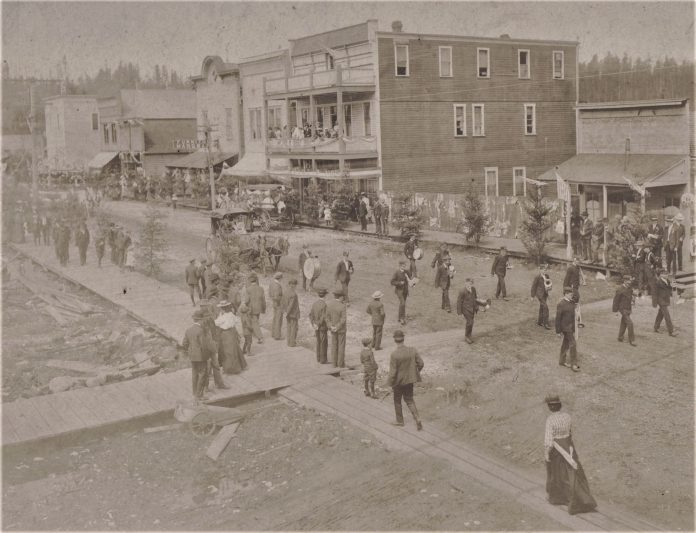
The interior of what is lovingly called the Old Bank in Tenino is deceptively small. It occupies the corner of Sussex and Olympia Streets in Tenino and is surrounded by the larger “L” shaped Campbell and Campbell building, which was home of a prosperous  pioneer mercantile. The two buildings share architectural features like the continuous cornice panel, but are separate structures. The bank, however, stands out with its iconic Corinthian column as a Tenino landmark. Within the bank a vault was constructed of solid masonry to protect the bank’s deposits. The cost of construction was estimated at $6,000.
pioneer mercantile. The two buildings share architectural features like the continuous cornice panel, but are separate structures. The bank, however, stands out with its iconic Corinthian column as a Tenino landmark. Within the bank a vault was constructed of solid masonry to protect the bank’s deposits. The cost of construction was estimated at $6,000.
In 1905, fire tore through the Tenino Business District, decimating the wooden structures with which the booming pioneer town was built. With its homegrown sandstone industry, the town vowed to rebuild in stone. And so, in 1906, construction began in earnest, shaping Tenino into the town it is today. That same year, Tenino was incorporated, Henry Keithahn, operator of the local creamery, was elected the town’s first mayor, and banker W. Dean Hayes was brought in to organize Tenino’s first bank.
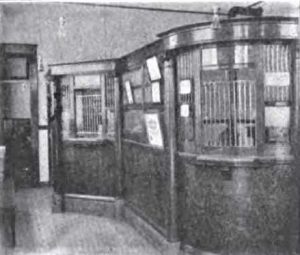
The State Bank of Tenino
The State Bank of Tenino opened its doors on May 7, 1907, starting with $10,000 in capital in the Miller Building during the construction of its new facility on Olympia Street. The State Bank of Tenino took up its permanent residence on May 9, 1908. The bank quickly gained the confidence of a town unaccustomed to formal banking. According to an article in The Tenino News, August 14, 1908, deposits by patrons of the institution amounted to nearly $67,000.
The State Bank of Tenino placed convincing ads in The Tenino News like this one from the September 18, 1913, edition: “Beware of Smooth Strangers. If all the money taken out of this community by smooth strangers and ‘get – rich – quick’ schemes had remained at home, it would be sufficient to pave every street in town. Why do you not put your money safely in your home bank where it will help you and everybody else in your community, and where you can get it when you want it! We pay 4% interest on savings accounts.”
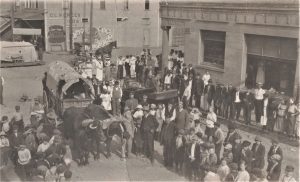
Or this ad from March 23, 1911: “Everybody should have a bank account no matter what his or her occupation, salary or income. It is the START. This is what counts most in the accumulation of money. An account once opened draws dollars to itself just as surely as a magnet draws steel. Your business and account is not too small to receive care and attention at this bank.”
According to Scott McArthur’s book The Decades of Boom and Bust, “The local bank was alert to the possibility of robbery. As a part of its own crime-prevention program, the bank passed out rifles to the business establishments at each end of town. They had one at the Titus Grange. The rifle was kept loaded. If there was a bank robbery in town, the citizens were supposed to shoot the robbers as they fled the town. It must have worked. There was never a bank robbery.”
The Citizen’s Bank of Tenino
In September 1914, the State Bank of Tenino failed in a scandalous fashion. Before Federal Reserve banks, smaller banks often kept their excess cash in larger federal banks. While Tenino’s bank was well managed, Hayes made the mistake of putting the extra cash from Tenino and his new bank in Olympia in the United States National Bank of Centralia. The Centralia institution was managed by Charles Gilchrist, who as it turned out was stealing from his own bank. When the Centralia bank failed it took Tenino’s bank and the Olympia Bank and Trust with it. A number of charges were filed against Hayes and Isaac Blumauer, the President of the Tenino Bank, but both were acquitted. However, Hayes, Blumauer and other shareholders were ordered to pay considerable sums and eventually recovered 50 cents on the dollar for their depositors. The bank quickly changed hands and by late December 1914, The Citizens Bank of Tenino opened its doors.
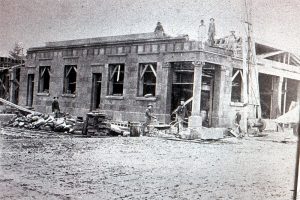
The Citizen’s Bank of Tenino had a strong run and plenty of money on deposit, until the banks creditors could not pay on their loans during the Great Depression. Consequently, the bank was unable to pay its depositors. Fearing a run on the bank, the Citizens Bank of Tenino locked its doors on December 6, 1931, and handed it over to the Superintendent of Banks.
Interestingly, a month earlier, Don Major advocated in the Tenino Independent the possibility of a town running its own script. Now that Tenino officially had a shortage of cash, the Chamber of Commerce held an emergency meeting where they agreed to run script, depositors were able to sign over 25% of the value of their Tenino Citizens Bank account to the Chamber and receive the new town currency. The paper script was printed in the newspaper office and signed by Don Major, the town Doctor F.W. Wichman, and Councilman A. H. Meyers. $3255 was printed, $1279 circulated, and $1079.75 redeemed. Because of the ease of counterfeiting paper script, a change came when samples for a new kind of wooden Christmas card came to town. After some experimentation wooden money was born.
When the Seattle Star ran the story of Tenino’s wooden money in February 1932, followed by other notable publications, the demand for wooden money outside of Tenino skyrocketed as collectors wanted to get in on the action. A total value of $10,308 of wooden money was printed. Only $40 was redeemed by the Chamber of Commerce.
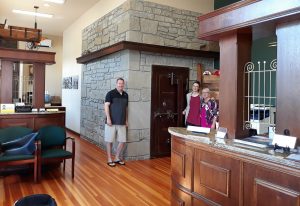
The original press which printed Tenino’s script is housed at the Tenino Depot Museum. The story of wooden money holds a special place in the hearts of historians and collectors alike and was featured on Season 20 Episode 5 of Mysteries at the Museum. Wooden money souvenirs can still be purchased at the Tenino Museum.
The Old Bank’s New Life
The bank building was purchased by the Tenino Chamber of Commerce for $2,400 with proceeds from the sale of Tenino wooden money and later sold to the city where they housed offices for a time. Several businesses have used the building over the years including another bank, realty offices, a gift shop, and flower shop. It sat vacant for a number of years, during which time there was considerable water damage.
An article from the 1970s by an unknown author has this interesting bit of information: “The bank’s vault was permanently sealed some time ago, said town administrator Bob Mosher. The vault unlock was broken and the unlock mechanism reportedly contained poisonous gas for foiling would-be safe crackers. Whether it really does contain such gas is open to question, but whoever tries to pry open the vault in the future ought to wear a gas mask for safe measure.”
Incidentally, though it’s unknown who opened it, the vault is open today to no ill effect.
Thankfully the Old Tenino Bank was lovingly restored by owners Sharon and Steve Thornily for which they received the Valerie Sivinski Award for Outstanding Achievement in Historic Preservation Rehabilitation Projects in 2015. The bank is now the office of Edward Jones financial advisor Chris Hallett.



















































